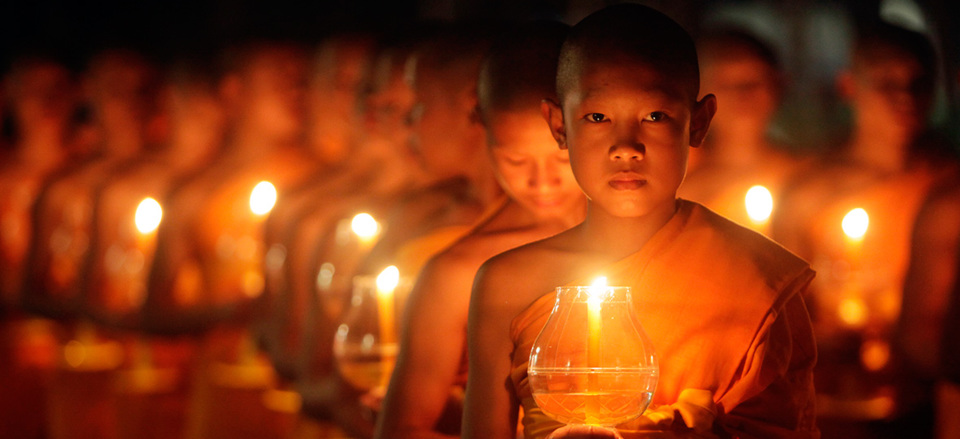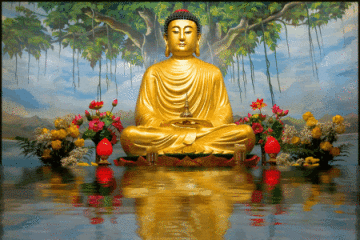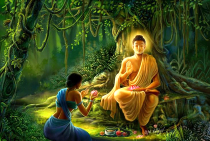
What Is Buddhism?
Buddhism Today
For more than 2,600 years, the religion we know today as Buddhism has been a primary inspiration behind many successful civilizations, the source of great cultural achievements and a lasting meaningful guide to the purpose of life for millions of people. Today, large numbers of men and women from diverse backgrounds throughout the world are following the uniqe Teachings of the Buddha. So what are his teachings?
.
The Teachings of the Buddha
Having realized the goal of Enlightenment, the Buddha spent the next 45 years teaching a Path which, when diligently followed, will take anyone regardless of race, class or gender to that same Perfect Enlightenment. The Teachings about this Path are called the Dharma, literally meaning "the nature of all things" or "the truth underlying existence". It is beyond the scope of this short sketch to present a thorough description of all of these Teachings but the following seven topics will give you an overview of what the Buddha taught:
1. The way of Inquiry
The Buddha warned strongly against blind faith and encouraged the way of truthful inquiry. In one of His best known sermons, the Kalama Sutra, the Buddha pointed out the danger in fashioning one's beliefs merely on the following grounds: on hearsay, on tradition, because many others say it is so, on the authority of ancient scriptures, on the word of a supernatural being, or out of trust in one's teachers, elders, or priests. Instead one maintains an open mind and thoroughly investigates one's own experience of life. When one sees for oneself that a particular view agrees with both experience and reason, and leads to the happiness of one and all, then one should accept that view and live up to it!
This principle, of course, applies to the Buddha's own Teachings. They should be considered and inquired into using the clarity of mind born of meditation. Only when one sees these Teachings for oneself in the experience of insight, do these Teachings become one's Truth and give blissful liberation. The traveller on the way of inquiry needs the practice of tolerance. Tolerance does not mean that one embraces every idea or view but means one doesn't get angry at what one can't accept. Further along the journey, what one once disagreed with might later be seen to be true. So in the spirit of tolerant inquiry, here are some more of the basic Teachings as the Buddha gave them.
2. The Four Noble Truths
The main Teaching of the Buddha focuses not on philosophical speculations about a Creator God or the origin of the universe, nor on a heaven world ever after. The Teaching, instead, is centred on the down-to- earth reality of human suffering and the urgent need to find lasting relief from all forms of discontent. The Buddha gave the simile of a man shot by a poison-tipped arrow who, before he would call a doctor to treat him, demanded to know first who shot the arrow and where the arrow was made and of what and by whom and when and where ... this foolish man would surely die before his questions could be well answered.
In the same way, the Buddha said, "The urgent need of our existence is to find lasting relief from recurrent suffering which robs us of happiness and leaves us in strife." Philosophical speculations are of secondary importance and they are best left until after one has well trained the mind in meditation to the stage where one has the ability to examine the matter clearly and find the Truth for oneself.
Thus, the central Teaching of the Buddha, around which all other teachings revolve is the Four Noble Truths:
1. That all forms of being, human and otherwise, are afflicted with suffering.
2. That the cause of this suffering is Craving, born of the illusion of a soul.
3. That this suffering has a lasting end in the Experience of Enlightenment (Nirvana) which is the complete letting go of the illusion of soul and all consequent desire and aversion.
4. That this peaceful and blissful Enlightenment is achieved through a gradual training, a Path which is called the Middle Way or the Eightfold Path.
Two Main Schools of Buddhism Facts
The real followers of the Buddha can practise this religion without adhering to any school or sect.
A few hundred years after the Buddha's passing away, there arose eighteen different schools or sects all of which claimed to represent the original Teachings of the Buddha. The differences between these schools were basically due to various interpretations of the Teachings of the Buddha. Over a period of time, these schools gradually merged into two main schools: Theravada and Mahayana. Today, a majority of the followers of Buddhism are divided into these two schools.
Basically Mahayana, especially Tibetan Buddhism grew out of the Buddha's teaching that each individual carries within himself the potential for Buddhahood. Theravadins say that this potential can be realized through individual effort. Mahayanists, on the other hand, believe that they can seek salvation through the intervention of other superior beings called Bodhisattas. According to them, Bodhisattas are future Buddhas who, out of compassion for their fellow human beings, have delayed their own attainment of Buddhahood until they have helped others towards liberation. In spite of this basic difference, however, it must be stressed that doctrinally there is absolutely no disagreement concerning the Dhamma as contained in the sacred Tripitaka texts. Because Buddhists have been encouraged by the Master to carefully inquire after the truth, they have been free to interpret the scriptures according to their understanding. But above all, both Mahayana and Theravada are one in their reverence for the Buddha. (For a short, excellent exposition on this topic, read Dr. W. Rahula, 'Theravada and Mahayana Buddhism', published by The Buddhist Missionary Society.)
The areas of agreement between the two schools are as follows:
-
Both accept Sakyamuni Buddha as the Teacher.
-
The Four Noble Truths are exactly the same in both schools.
-
The Eightfold Path is exactly the same in both schools.
-
The Pattica-Samuppada or teaching on Dependent Origination is the same in both schools.
-
Both reject the idea of a supreme being who created and governed this world.
-
Both accept Anicca, Dukkha, Anatta and Sila, Samadhi, Panna without any difference.
Some people are of the view that Theravada is selfish because it teaches that people should seek their own salvation. But how can a selfish person gain Enlightenment? Both schools accept the three Yana or Bodhi and consider the Bodhisatta Ideal as the highest. The Mahayana has created many mystical Bodhisattas, while the Theravada believes that a Bodhisatta is a man amongst us who devotes his entire life for the attainment of perfection, and ultimately becomes a fully Enlightened Buddha for the well-being and happiness of the world.
The terms Hinayana (Small Vehicle) and Mahayana (Great Vehicle) are not known in the Theravada Pali literature. They are not found in the Pali Canon (Tripitaka) or in the Commentaries on the Tripitaka.
Theravada Buddhists follow orthodox religious traditions that had prevailed in India two thousand five hundred years ago. They perform their religious services in the Pali language. They also expect to attain the final goal (Nirvana) by becoming a Supreme Enlightened Buddha, Pacceka Buddha, or an Arahant (the highest stage of sainthood). The Majority of them prefer the Arahantahood. Buddhists in Sri Lanka, Burma, and Thailand belong to this school. Mahayanists have changed the old religious customs. Their practices are in accordance with the customs and traditions of the countries where they live. Mahayanists perform their religious services in their mother tongue. They expect to attain the final goal (Nibbana) by becoming Buddhas. Hence, they honor both the Buddha and Bodhisatta (one who is destined to be a Buddha) with the same respect. Buddhists in China, Japan and Korea belong to this school. Most of those in Tibet and Mongolia follow another school of Buddhism which is known as Vajrayana. Buddhist scholars believe that this school inclines more towards the Mahayana sect.
It is universally accepted by scholars that the terms Hinayana and Mahayana are later invention. Historically speaking, the Theravada already existed long before these terms came into being. That Theravada, considered to be the original teaching of the Buddha, was introduced to Sri Lanka and established there in the 3rd century B.C., during the time of Emperor Asoka of India. At that time there was nothing called Mahayana.
Mahayana as such appeared much later, about the beginning of the Christian era. Buddhism that went to Sri Lanka, with its Tripitaka and Commentaries, in the 3rd Century B.C., remained there intact as Theravada, and did not come into the scene of the Hinayana-Mahayana dispute that developed later in India. It seems therefore not legitimate to include Theravada in either of these two categories. However, after the inauguration of the World Fellowship of Buddhists in 1950, well-informed people, both in the East and in the West, use the term Theravada, and not the term Hinayana, with reference to Buddhism prevalent in South-east Asian countries. There are still outmoded people who use the term "Hinayana". In fact, the Samdhi Nirmorcana Sutra (a Mahayana Sutra) clearly says that the Sravakayana -- Theravada, and the Mahayana constitute one Yana (ekayana) and that they are not two different and distinct 'vehicles'. Although different schools of Buddhism held different opinions on the teaching of the Buddha, they never had any violence or blood shed for more than two thousands years. This is the uniqueness of Buddhist tolerance.










